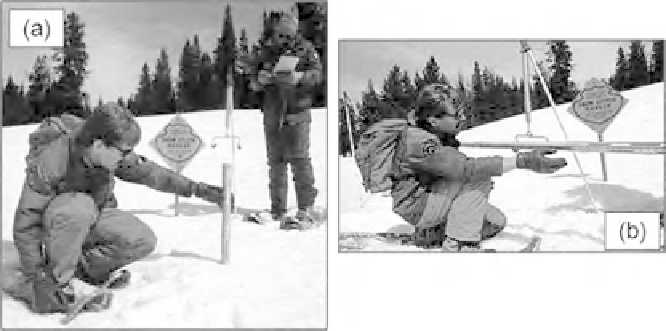Geoscience Reference
In-Depth Information
Figure 12.7
Snow course
measurement: (a) inserting
the sampling probe; and
(b) weighting the probe and
snow contained in it after
insertion. (From US National
Atlas, 2011.)
Radioactive techniques have been used to measure snow fall. Experimental
measurements have been made which involve installing a radiation source
such as cobalt-60 or caesium-137 at ground level and a radiation detector
above the ground. The reduction in detector counts as snow is deposited above
the source and below the detector is a measure of snow water equivalent.
However, this method is dangerous and expensive, and it has not gained
acceptance. Much more successful is the measurement of regional snow cover
over large areas made by flying an aircraft along predefined tracks and measuring
the gamma ray emission from the ground. A baseline gamma ray emission
must be established along the flight tracks used before snow falls, and subse-
quent flights must accurately follow the same flight path later in the season.
Ground truth measurements are also required at sample locations along the
flight path to improve the accuracy of the estimated area-average snowpack.
In the USA, the National Operational Hydrologic Remote Sensing Center
routinely undertakes successful measurements of snow cover across the north-
ern states in this way.
In some situations, estimates of snowpack are required to guide the manage-
ment of the water resources that will become available later in the season when the
snow melts and enters rivers. For this purpose, s
now courses
have been established
at preselected sample locations as indices of snowfall, and empirical relationships
have been established between measured melt season river flow and the snow
cover measured at these locations. This management technique is used in the
western mountain ranges of the USA which are source areas for the rivers that
provide water to heavily populated areas downriver. But the technique is labor
intensive. It involves observers accessing selected snow courses in the mountains,
inserting long tubes which take a core of the snowpack present, and weighing the
tube before and after insertion (Fig. 12.7).
Over recent decades an alternative to snow courses has been developed in the
form of snow pads or snow pillows. These are increasingly common in the western
USA. The technique involves 'weighing' the amount of snow resting on a thin





